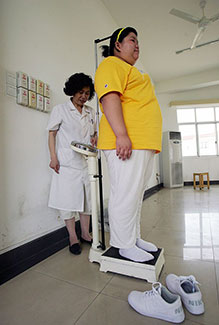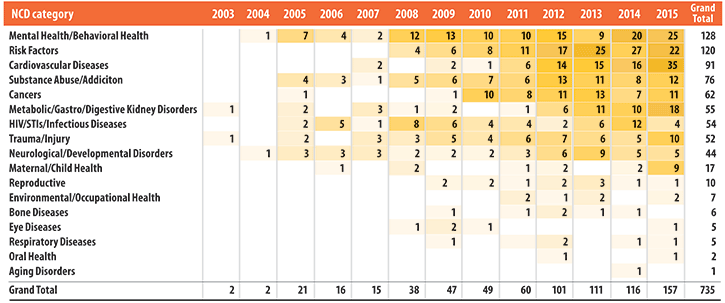Fogarty programs spur noncommunicable diseases (NCD) research, build capacity
March / April 2019 | Volume 18, Number 2
By Shana Potash
At the start of the century, as the threat of noncommunicable diseases (NCDs) in the developing world was emerging, Fogarty launched a series of programs to prepare local scientists to address the looming crisis, which claims 32 million lives each year. Between 2001 and 2017, Fogarty and its NIH partners invested nearly $80 million to establish NCD research partnerships between U.S. and low- and middle-income country (LMIC) institutions, and build related research training programs.

Photo by China Photos/Getty Images
Noncommunicable diseases (NCDs)
claim 32 million lives in developing
countries each year. To help address
the epidemic, Fogarty has supported
NCD research and training programs
since 2001.
Under the Fogarty programs, more than 600 investigators have received long-term NCD research training and, along with their mentors, have addressed a variety of topics from cardiovascular disease to aging disorders, and mental health to environmental health, publishing nearly 1,000 articles. Researchers have examined NCDs across the lifespan; sought to understand how diseases interact with each other; and explored risk factors and other cross-cutting issues. In addition to research and training, the nearly 80 funded projects spurred the creation of curricula and degree programs, and new health practices and policies in countries throughout the developing world.
Three of Fogarty’s NCD programs were reviewed recently by the Center’s Division for International Science Policy, Planning and Evaluation to determine how the initiatives enhanced research collaborations and built sustainable research capacity in NCDs. The team examined grant and publications data, surveyed U.S. investigators and foreign collaborators, and interviewed Fogarty staff to determine the impact of the NCD programs. The
findings have been posted online and include recommendations for future priorities.
The evaluation and the
latest Fogarty funding opportunities for NCD research training programs come at a critical time. Heart disease, cancer, diabetes and other NCDs disproportionately affect people in poorer countries. More than three-quarters of all NCD deaths globally occur in LMICs, according to the WHO. Driven by an aging population, rapid urbanization, unhealthy lifestyles and other forces, the burden of these chronic diseases is expected to increase further unless proven interventions are implemented. Part of that challenge, as noted in a 2018 WHO report, is that many countries lack research capacity.
“Noncommunicable diseases are a complex problem, and research and training needs continue to evolve,” said Fogarty Director Dr. Roger I. Glass. “This evaluation shows the substantial progress we have made but also points out the tremendous need for continued support.”
NCD Lifespan Program Objectives:
- Strengthen research capacity of LMIC institutions so they can become national, regional and international centers of expertise in NCD research
- Support multidisciplinary research training across the research continuum
- Train a cadre of LMIC scientists in NCD research that will advance science and contribute to changes in clinical practice and public health policy
- Support training-related research that is directly relevant to the health priorities of the LMIC
- Integrate with existing NCD research and public health programs in the LMIC
- Strengthen core research support capabilities needed to manage grants at an LMIC institution
NCD Lifespan program: 2011 to present
Programs evolved to meet new challenges
Fogarty’s NCD research training programs began with 14 grants awarded through the International Clinical, Operational and Health Services Research and Training Award (ICOHRTA) in 2001. Several years later, after an update to the Global Burden of Disease (GBD) Study highlighted the NCDs with the highest burden in developing countries, Fogarty launched another program focusing on cancer, lung disease, diabetes and cardiovascular disease, known as the Noncommunicable Chronic Diseases Research Training Program (NCoD). Those two programs were eventually consolidated into a new initiative when program officer Dr. Kathleen Michels recognized the need for a more holistic approach. The
Chronic, Noncommunicable Diseases and Disorders Across the Lifespan Research Training Program (NCD-Lifespan), which began in fiscal year 2011 and continues today, emphasizes research across the aging continuum and aims to support the science needed to develop and implement evidence-based interventions.
While not part of the evaluation, Fogarty has also seeded the NCD researcher pipeline through other programs focused on
brain disorders,
trauma and injury, and
tobacco cessation. In addition, the Center has broadened the disciplines included in its
Fellows and Scholars program to include cardiology, diabetes, cancer, kidney disease and other NCD specialties.
NCD research training programs have impact
The three NCD programs combined provided substantial training for 660 scientists. Those opportunities, which lasted six months or more, included fellowships and certificate programs, master’s degrees, research and professional doctorate degrees, and postdoc positions. Nearly half of the long-term participants were in nondegree programs. While long-term activities were the core of the programs, most grants also offered workshops and other short-term opportunities to enhance skills in specific areas such as lab techniques, grant writing and research protocol development.
As signs of success, trainees and grantees were able to leverage their experiences to obtain funding for further research or research training projects. Half of the survey respondents reported having at least one trainee who successfully obtained additional funding. Many former trainees now have positions in academia where, as the evaluation described, their roles may range from “instructing the next generation of researchers, to leading clinical rounds at a university hospital, to conducting research in a lab.” Other alumni have assumed roles within the government or with not-for-profit organizations.
Building institutional capacity - creating a strong research environment - is another area where Fogarty’s NCD programs have made an impact. Grantees and collaborators from around the world provided dozens of examples of how their awards helped create courses or certificate and degree programs in topics that include cancer epidemiology, environmental sciences, nutrition, mental health, maternal and child health, and the ethics of clinical trials. Respondents also reported they had produced training materials and secured LMIC government commitments to increase staffing. The award, many said, enabled institutions to recruit or retain faculty interested in NCD research.
Case studies demonstrate impact on NCD policy
The evaluation contains several cases studies representative of how findings from NCD research projects have influenced health policies and programs in developing countries.

Photo courtesy of Dr. Bahr Weiss
This 5-year-old Vietnamese girl was a participant in a study
that increased her country’s interest in child mental health
services.
Findings from a research project in Vietnam helped convince the Ministry of Health to make child mental health a priority, and the national health insurance started covering certain conditions. The research was the product of a collaboration between Vietnam National University and Vanderbilt University in the U.S. Investigators conducted Vietnam’s first nationally representative child mental health epidemiology survey. Among its findings, significant behavioral mental health problems were associated with an approximately 350 percent increase for risk of academic functional impairment.
The opioid Tramadol has become extremely popular in the Middle East, including Egypt where a dangerously toxic version is sold cheaply on the streets. A research training collaboration between Cairo University and the University of California, Los Angeles conducted a multi-country study of Tramadol addiction. Evidence from this study and others helped inform the WHO, and the governments of Egypt and the United Arab Emirates about the treatment needs of Tramadol users and promoted the approval of appropriate medications in the two countries. The research found that
grand mal seizures occurred in 28.5 percent of study participants during prior withdrawal periods. Because of that, treatment centers in Egypt and the UAE have seizure prevention strategies as part of their withdrawal management plans.
Outcomes include papers, protocols and products
NCD Publications and Impact
| Number of citations (times cited) | 7,761 |
| Mean citation count | 13.13 |
| Median citation count | 7 |
Bibliometric indicators for NCD articles supported by Fogarty programs, 2003-2015
Fogarty’s programs have added to the body of knowledge related to NCDs. The review found that 982 scientific publications citing an NCD grant were produced between 2003 and 2017. The three most common topics were mental health, risk factors such as obesity and nutrition, and cardiovascular diseases.
A bibliometric analysis examined, among other things, citation impact and collaborations. A key finding was that 69 percent of alumni grantees published at least three or more articles with an LMIC colleague after their NCD grant ended, signaling they had kept up the scientific relationship that was formed because of the program.
“Overall the results of the bibliometric analysis and coauthorship network suggest that grantees and alumni are producing high quality scientific articles, continuing to foster collaborations between U.S. and foreign scientists, and have contributed to important empirical evidence to combat NCDs in LMICs,” as noted in the assessment.
Grantees and their collaborators have made other contributions to science. When asked what their project produced, 19 investigators - nearly half of those who responded - reported developing clinical protocols for use in LMICs. They include a clinical trial of a therapy targeting breast cancer and a protocol to manage sickle cell disease. Seventeen grantees reported building patient registries and databases; 11 created software and analytic tools; and four produced devices or prototypes.
Top Categories of NCD Articles 2003-2015

Note: Articles can focus on more than one research area. As such, a grant can be counted in more than one NCD category.
Table description: Table of the NCD categories for publications citing a Fogarty NCD grant covered by the review. The table shows totals for each of 17 NCD categories for each year 2003 though 2015. Access the
full data in a tab-delimited text file.
Challenges and unmet needs
While progress has been made, tackling NCDs will require many more well-qualified researchers and mentors, according to the evaluation. Grantees and collaborators who were surveyed named a range of research topics that still require attention. “Adding to this need, the diversity of NCDs that make up the epidemic adds complexity to the process of building capacity. For example, a country may have built a critical mass of researchers in cardiovascular disease, but there remains a lack of experts that can manage the growing diabetes, trauma/injury or hypertension issues in the country,” the review stated.
Many grantees pointed to implementation science research as an area for growth, given its value in developing health policy guidelines and determining how to adapt or scale up interventions. Funding was an issue, with many grantees noting that even though LMIC governments may recognize the benefit of NCD research, their national budgets are too strained to support it. Creating protected time for research was also identified as an ongoing challenge, given that faculty at LMIC institutions often have competing interests.
When asked about hurdles they faced in building capacity, some grantees said that five years of funding, which is typical for the research training grant mechanism (known as D43), was not long enough to effect change in some countries. The biggest obstacles within the research infrastructure at LMICs were related to grant management and accounting, and institutional review boards that were either lacking or slow to give approval.
Recommendations and next steps
Recognizing that LMICs are facing the dual burden of NCDs and infectious diseases, the evaluation recommended collaboration between those scientific communities and suggested that future iterations of the NCD program consider how to prioritize the nexus between NCDs and infectious diseases. Encouraging such comorbidity research, the review noted, will help build a highly skilled and nimble research workforce.
Priority also should be given to research topics that cut across diseases, including prevention and implementation science, common risk factors, developmental origins, maternal and child health, and stigma. An emphasis also should be placed on research areas that so far have been under-represented in research training such as metabolic disorders, hearing issues and chronic kidney diseases. Additionally, investigators may want to consider requiring each trainee to write and submit a grant proposal, because the process and feedback could help them take a critical step toward becoming an independent investigator.
Some of the evaluation’s findings have been incorporated into the newest funding opportunity announcements, which have deadlines in November 2019 and 2020. In a further effort to build institutional capacity, renewal applications funded solely by Fogarty must come from the foreign site. The move away from U.S.-led projects is intended to bolster LMIC institutions’ capacity to secure their own funding. New applications are expected to propose collaborations with a single LMIC institution as the major partner, thereby concentrating resources and training opportunities at one institution so a strong foundation is built.
Fogarty has additional funding opportunities to help NCD training program alumni and other early-career researchers make the transition to independent investigator. The
Emerging Global Leader Award gives junior faculty at LMIC institutions financial support and protected time for research. And the
Global Noncommunicable Diseases and Injury Across the Lifespan: Exploratory Research program gives LMIC investigators the opportunity to jumpstart research programs related to NCDs, trauma and injury.
“These programs can prime the NCD research pipeline in LMICs by giving younger scientists additional opportunities to develop their research skills,” said Fogarty’s Dr. Glass. “It’s our hope these experiences will propel them toward becoming the scientific leaders in their countries who will in turn prepare future generations of researchers.”
Strong NIH support for Fogarty’s NCD programs
The NCD research programs have enjoyed broad support across NIH. Over time, Fogarty has had a dozen partners:
- National Cancer Institute (NCI)
- National Center for Complementary and Integrative Health (NCCIH)
- National Institute on Aging (NIA)
- National Institute on Alcohol Abuse and Alcoholism (NIAAA)
- Eunice Kennedy Shriver National Institute of Child Health and Human Development (NICHD)
- National Institute on Drug Abuse (NIDA)
- National Institute of Dental and Craniofacial Research (NIDCR)
- National Institute of Environmental Health Sciences (NIEHS)
- National Institute of Mental Health (NIMH)
- National Institute of Neurological Disorders and Stroke (NINDS)
- National Institute of Nursing Research (NINR)
- NIH Office of Dietary Supplements (ODS)
More Information
To view Adobe PDF files,
download current, free accessible plug-ins from Adobe's website.